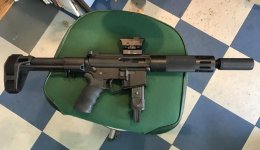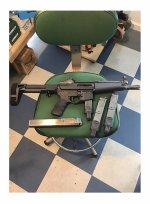I'm an old fart so forgive my asking. What's the attraction of these. I've shot only one gun so equipped and to me at least it was a non-event.
The brace story is the a epitome of the slippery slope argument; but this time it worked in favor of gun owners.
The ATF has a tax stamp requirement and permission to buy/own
any rifle with a short barrel, i.e., under 16”. That is an SBR.
However, if the rifle barrel was under 16” and there was no stock attached to the receiver, it was classified as a non-controlled pistol. There were very few of these around.
The cry went up from manufacturers of the most popular semi-auto rifle platform in America, the AR-15 pattern, that this was unfair. The AR recoil system required an extension out the rear of the receiver, unlike most other rifle-like pistols.
OK, said the ATF, you can still call that a pistol. ATF will call that extension a stabilizing brace, as long as is it is not shouldered.
Then manufacturers went from a simple buffer tube covered with foam to more elegant “braces” with arm bands for stabilization and even vertical fins at the rear for better stabilization (Sig 2012). ATF said OK, as long as it was not “shouldered”(2014-15).
Then such braces progressed even more toward looking like rifle stocks, but they were made slightly differently and still marketed as braces.
Despite the 2014 ATF proscription against shouldering these new stock-like braces, people did it anyway.
ATF looked at it, and decided, eh, let them do it (2017),
occasionally. So shouldering a pistol for firing, as long as it was with a brace rather than a stock and within the realm of the undefined term “occasionally”, was now OK. Sales of AR style pistols skyrocketed as the advantages to such a compact system were recognized.
Now the ATF thinks it went too far and is trying to climb back up that slippery slope. These have been arbitrary administrative decisions unsupported by any collection of public data showing such configured guns represent any more danger to the public than any other configuration.
Now, what’s the big deal? IOW, why should anyone care?
I noted in my post above a number of advantages of a rifle configured this way. Special forces have long used such short barreled rifles for CQB, but they didn’t have to deal with the restrictions ATF puts on civilians for similarly configured rifles.
In the space of a few short years, the concept of an SBR becoming an uncontrolled pistol by not having a fixed stock was a big deal. I don’t know how many hundreds of thousands of these “pistols” have been sold, but it wouldn’t surprise me if it approaches a million.
If you buy an AR pistol receiver, registered as a pistol, you can legally put any upper you want on it—and a stock—and it is a legal rifle. You can’t do that with a receiver registered as a rifle. Your same receiver can be a 9mm, .300 BO, 5.56mm, etc., with any barrel length under 16” you want.
Now, any enhancement to the uncontrolled pistol/rifle/SBR concept that makes it easier to shoot accurately and quickly with rifle cartridges is a hot seller for those looking for compact, high capacity, easily fired, more powerful than a pistol options. Modern “braces” do that. Take away the ability to shoulder that “pistol”, occasionally, and you lose about 80% of its utility.
Comparing the underpinnings of this ruling to the bumpstock is apples-to-oranges, IMO. There were very, very few bump stock configurations ever sold, and they were definitely only a novelty. A rifle caliber pistol with a 30-round capacity is a formidable, useful tool. We have it now, legally. Take it away without justification, and I believe there will be a case against the ATF that won’t even reach the Supreme Court with the ATF losing. If it does make it to the SC, I believe the ruling will be shown to be unnecessary government overreach lacking sufficient justification.





